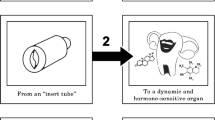Abstract
This study was designed to examine whether testosterone needs to be converted to estradiol in order to exert fully its effects on sexuality in the human male. Administration of the estrogen receptor antagonist tamoxifen and the aromatase inhibitor testolactone were without effect on parameters of sexual functions. Replacement of testosterone substitution therapy of agonadal men by dihydrotestosterone was likewise not associated with any change of sexual functioning. Administration of dihydrotestosterone to eugonadal men led to a transient increase of nocturnal sexual dreams and erections and irritability, waning after 3–4 weeks of dihydrotestosterone administration. It is concluded that aromatization of testosterone is not required and that dihydrotestosterone maintains sexual functions in the adult male with an established sex life.
Similar content being viewed by others
References
Davidson, J. M., Kwan, M., and Greenleaf, W. J. (1982). Hormonal replacement and sexuality in men. InClinics in Endocrinology and Metabolism 11, 599–625.
Emment, Y., Collins, W. P., and Sommerville, I. F. (1972). Radio-immunoassay of oestrone and oestradiol in human plasma.Acta Endocrinol. (Copenhagen) 69: 567–576.
Gooren, L. J. G., van der Veen, E. A., van Kessel, H., and Harmsen-Louman, E. (1984a). Estrogens in the feedback regulation of gonadotropin secretion in men: Effects of administration of estrogen to agonadal subjects and the anti-estrogen tamoxifen and the aromatase inhibitor Δ′-testolactone to eugonadal subjects.Andrologia 16: 568–577.
Gooren, L J. G., van der Veen E. A., van Kessel, H., Harmsen-Louman, W., and Wiegel, A. R. (1984b). Androgens in the feedback regulation of gonadotropin secretion in men: Effects of administration of dihydrotestosterone to eugonadal and agonadal subjects and of spironolactone to eugonadal subjects.Andrologia 16: 289–298.
Kurl, R. N., and Morris, I. D. (1978). Differential depletion of cytoplasmatic high affinity oestrogen receptors afterin vivo administration of the antioestrogens clomiphene, MER-25.Brit. J. Pharmacol. 62: 487–493.
Luisi, M., and Franchi, R. (1980). Double-blind group comparative study of testosterone undecanoate and mesterolone in hypogonadal male patients.J. Endocrinol. Invest. 3: 305–308.
MacLusky, N. L., and Naftolin, F. (1981). Sexual differentiation of the central nervous system.Science 211: 1294–1303.
McNair, L., Douglas, M., and Lorr, M. (1964). An analysis of mood in neurotics.J. Abnorm. Psychol. 69: 620–627.
Nieschlag, E., Mauss, J., Coert, A., and Kicovic, P. M. (1975). Plasma androgen levels in men after oral administration of testosterone or testosterone undecanoate.Acta Endocrinol. 79: 366–370.
Pratt, J. J., and Woldring, M. G. (1976). Radioimmunoassay specificity and the “first-come, first served” effect.Clin. Chim. Acta 68: 87–94.
Pratt, J. J., Wiegman, T., Lappöhn, R., and Woldring, M. G. (1975). Estimation of plasma testosterone without extraction and chromatography.Clin. Chim. Acta 59: 337–345.
Puri, V., Puri, C. P., and Anand Kumar, T. C. (1981). Serum levels of dihydrotestosterone in male rhesus monkeys estimated by a non-chromatographic radio-immunoassay method.J. Steroid Biochem. 14: 877–884.
Sachs, B. D., and Garinello, L. D. (1980). Hypothetical spinal pacemaker regulating penile reflexes in rats: Evidence from transsection of spinal cord and dorsal penile nerves.J. Comp. Physiol. Psychol. 94: 530–535.
Segaloff, A., Weeth, J. B., Meyer, K. K., Rongone, E. L., and Cunningham, M. E. (1962). Hormonal therapy in cancer of the breast: Effect of oral administration of Δ′-testolactone on clinical course and hormonal excretion.Cancer 22: 663–666.
Skakkebaek, N. E., Bancroft, J., Davidson, D. W., and Warner, P. (1981). Androgen replacement with oral testosterone undecanoate in hypogonadal men: A double-blind controlled study.Clin. Endocrinol. 14: 49–61.
Whitehead, A., and Matthews, A. (1976) Attitude change during behavioural treatment of sexual inadequacy.Brit. J. Soc. Clin. Psychol. 16: 275–281.
Author information
Authors and Affiliations
Rights and permissions
About this article
Cite this article
Gooren, L.J.G. Human male sexual functions do not require aromatization of testosterone: A study using tamoxifen, testolactone, and dihydrotestosterone. Arch Sex Behav 14, 539–548 (1985). https://doi.org/10.1007/BF01541754
Issue Date:
DOI: https://doi.org/10.1007/BF01541754



